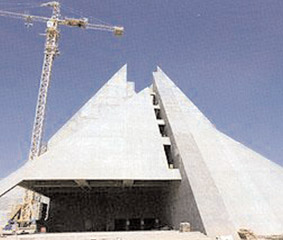 IN the heart of el-Minya in Upper Egypt, about 240km south of Cairo, Tel el-Amarna Museum will soon open.
IN the heart of el-Minya in Upper Egypt, about 240km south of Cairo, Tel el-Amarna Museum will soon open.
It will be the first museum dedicated to monuments connected with Akhenaten and his wife, Nefertiti. However, it won't contain the head of Nefertiti, which was smuggled out of Egypt by a German scientist early last century and which the German authorities refuse to return, despite Egyptian diplomatic efforts.
The museum, being built at a cost of LE100 million ($18 million), is located on an area of 25 feddans (acres), overlooking the River Nile.
It will eventually have a pyramidal shape, evoking Ancient Egypt. It will contain 14 halls and an auditorium accommodating 800 people, as well as an administrative building, a cafeteria and an anchorage for boats.
The new museum will contain antiquities connected with Akhenaten, from when he lived in Luxor and then el-Minya, as well as antiquities connected with his wife, Nefertiti, with whom he lived in Tel el- Amarna.
The museum will contain statues of Akhenaten and his wife, as well as other Pharaonic items, dating back to King Akhenaten's reign, stressing the monotheism that prevailed in Ancient Egypt at the time.
It will include finds from Karnak and Luxor, as well as discoveries made by the British archaeological mission at Tel el-Amarna.
There will be a large library, ideal for researchers.
Akhenaten was apparently more interested in religious reform than foreign policy or running the Empire.
Following Akhenaten's death, the priests of Thebes destroyed his city and created a new capital at Tel el- Amarna, vestiges of which exist to this day.
Mystery shrouds the last years of Akhenaten's reign and his death. No-one knows where he's buried; the tomb he had built for himself in the eastern part of the city of Akhet Atoun is empty, while his coffin shows no traces of having contained a mummy.
The remains of a coffin were found in 1935 in Luxor. In 1957, a heliographic specialist examined what was written on the coffin and was able to prove that it concerned King Akhenaten.
As the museum nears completion, hopes arise in Egypt that Nefertiti's bust will be brought back from the Berlin Museum.
It was found by a German scientist in 1912 in Tel el-Amarna. He had it transported whole to his home in Zamalek and then managed to have it smuggled out of the country, hidden under some worthless pieces of broken pottery.



